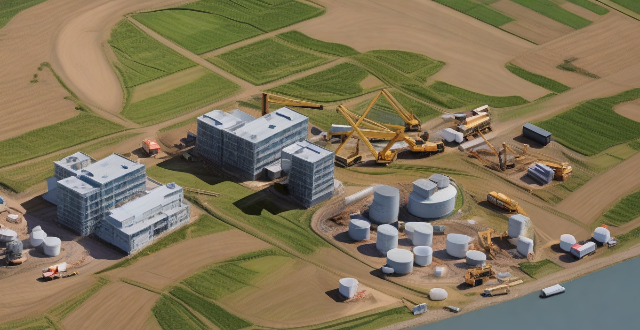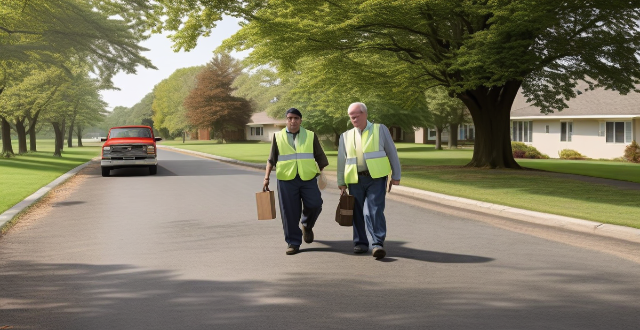Safety Structural

In what ways do building codes contribute to overall structural safety ?
Building codes are regulations that ensure the design, construction, and maintenance of buildings adhere to certain standards, promoting structural safety. They prevent the use of substandard materials and shoddy workmanship, require buildings to withstand environmental factors, mandate fire-resistant materials and safety features, address accessibility and egress issues, and encourage energy efficiency. Overall, building codes contribute significantly to creating safer, more resilient structures.

Is it safer to stay in a high-rise building during an earthquake or evacuate ?
The article discusses the safety considerations for staying in or evacuating a high-rise building during an earthquake. It outlines the advantages and disadvantages of both options, such as structural integrity, risk of falling debris, and access to emergency services. The decision should be based on factors like the severity of the earthquake, the building's structural integrity, and available safety precautions. Being prepared with an emergency kit and knowledge of proper safety procedures is crucial for ensuring well-being during these events.

What are the consequences of ignoring safety standards in construction work ?
Ignoring safety standards in construction work can lead to severe consequences, including risk to human life, project delays, financial losses, reputation damage, legal implications, environmental impact, and public safety concerns. Adhering to these standards is crucial for the well-being of all involved parties and the success of the project.

How often should safety inspections be conducted on a construction site ?
Safety inspections are crucial for construction sites to prevent accidents and ensure worker well-being. The frequency of these inspections depends on the project's size, complexity, type of work, and local regulations. This guide provides a detailed overview of how often safety inspections should be conducted: 1. Daily Inspections: Include visual checks, tools and equipment, and personal protective equipment (PPE). 2. Weekly Inspections: Cover structural integrity, electrical systems, and fire safety. 3. Monthly Inspections: Assess environmental hazards, emergency response plans, and site cleanliness. 4. Quarterly Inspections: Conduct comprehensive site assessments, review training updates, and ensure regulatory compliance. Unannounced spot checks should also be performed throughout the project to maintain safety awareness among workers. Safety should always be a top priority on any construction site, and regular inspections are essential for achieving this goal.

What are the most effective flood control measures ?
Effective flood control measures include both structural and non-structural approaches. Structural measures involve the construction of physical barriers such as dams, levees, embankments, dikes, seawalls, floodwalls, and floodgates to prevent or contain floodwaters. Non-structural measures include flood forecasting, early warning systems, land use planning, floodproofing, elevation, flood insurance, financial aid, public awareness campaigns, community drills, volunteer programs, and neighborhood watch programs. These measures work together to mitigate the risks and impacts of flooding, protecting lives and property.

How can technology be utilized to enhance safety protocols in construction projects ?
The text discusses how technology can enhance safety protocols in construction projects. Wearable technology, such as smart helmets and vests, drone technology for aerial surveillance and 3D mapping, Internet of Things (IoT) sensors for environmental and structural health monitoring, Virtual Reality (VR) and Augmented Reality (AR) for safety training and real-time information, and mobile applications for immediate communication and health monitoring are some of the tools and systems that have been developed to reduce risks and ensure the well-being of workers on site. The integration of these technologies is not just about introducing new gadgets, but about creating a culture of proactive risk management.

How do safety drills help identify potential hazards in the workplace ?
Safety drills are crucial exercises to simulate and identify potential hazards in the workplace. They help highlight weak links in safety procedures, test equipment and infrastructure, enhance visibility of hazardous areas, train for unexpected circumstances, and promote a culture of safety. By conducting regular drills, organizations can reduce accidents and ensure a safer environment for employees.

How do weather conditions affect building safety during construction ?
The text discusses the impact of various weather conditions on building safety during construction. It highlights the risks associated with extreme heat, cold weather, rain and water, strong winds, snow and ice, and lightning and thunderstorms. The conclusion emphasizes the importance of monitoring weather forecasts and adjusting working procedures to ensure worker safety.

How can we prevent flooding in urban areas ?
Flooding in urban areas is a pressing issue that calls for multifaceted solutions. The strategies include enhancing infrastructure resilience through green infrastructure development, improved drainage systems, and structural flood protection measures. Risk management and early warning systems are also crucial, encompassing risk assessment, community participation, hydrological monitoring, weather forecasting technology, and public alert systems. Emergency response plans involving evacuation routes, temporary shelters, and rescue services coordination further strengthen the overall approach. A combination of structural and non-structural strategies is recommended for effective adaptation to rising flood risks. Urban planners, engineers, and policymakers must collaborate to create cities that are resilient, safe, and capable of handling climate change's uncertainties.

What are the impacts of extreme weather events on building designs ?
Extreme weather events significantly impact building designs, affecting structural integrity, energy efficiency, and sustainability. To withstand high winds, heavy rains, and seismic activity, buildings must be designed with increased resilience using advanced materials and construction techniques that enhance their structural integrity. Improved foundations are also necessary to support the weight of buildings and resist forces exerted by extreme weather conditions. Energy efficiency is another area impacted by extreme weather events. Buildings must be designed to minimize heat loss or gain during extreme temperatures, requiring enhanced insulation and proper sealing of windows and doors. Incorporating renewable energy sources such as solar panels and wind turbines can reduce reliance on non-renewable energy sources and make buildings more sustainable. Sustainability is also a crucial factor in building designs affected by extreme weather events. Green roofs and walls help reduce the urban heat island effect, improve air quality, provide insulation, and absorb rainfall. Water management systems, including rainwater harvesting and permeable surfaces, are essential for coping with floods and droughts. Overall, architects and engineers must consider factors such as structural integrity, energy efficiency, and sustainability when designing buildings to ensure they can withstand extreme weather conditions while minimizing their environmental impact. By incorporating advanced materials, construction techniques, renewable energy sources, green roofs and walls, and effective water management systems, we can create buildings that are both resilient and sustainable.

What are the effects of extreme weather events on road safety and transportation infrastructure ?
This text discusses how extreme weather events such as heavy rain, snowstorms, hurricanes, tornadoes and heat waves can impact road safety by reducing visibility, making roads slippery or icy, causing flooding or high winds, throwing debris onto roads, causing power outages and melting tarmac. It also explains how these events can affect transportation infrastructure by causing structural damage to bridges and overpasses, washing away their foundations, creating potholes, cracks and breaks on roads and highways, causing power outages and damaging power lines and traffic signals.

How do safety regulations affect the manufacturing industry ?
Safety regulations are critical in manufacturing for worker safety, environmental protection, and product quality assurance but can increase costs and administrative burden while potentially slowing innovation.

How can parents effectively teach their children about safety ?
Teaching children about safety is crucial for their well-being. Parents can effectively teach their children about safety by establishing clear rules, educating them about potential dangers, practicing safety drills, encouraging open communication, and modeling safe behavior. By doing so, children will develop awareness and the ability to protect themselves from potential dangers.

What safety measures are in place on cruise ships ?
Cruise ships implement various safety measures to ensure the well-being of passengers and crew, including muster drills, life-saving equipment, fire safety systems, medical facilities, security personnel, emergency response plans, navigation systems, and regular maintenance checks.

How can technology be used to enhance child safety education ?
Technology can significantly enhance child safety education through various strategies such as interactive learning applications, virtual reality experiences, online safety courses, wearable devices, and social media engagement. These tools not only make learning fun and engaging but also provide practical, real-world simulations that help children develop essential safety skills. By utilizing these modern methods, we can equip the younger generation with the knowledge and confidence needed to stay safe in a rapidly changing world.

What is the importance of using standardized safety symbols and colors on safety signs ?
Using standardized safety symbols and colors on safety signs is crucial for promoting a safe working environment. These signs convey clear, concise information to employees, visitors, and emergency responders about potential hazards and necessary precautions. The importance of these symbols and colors in enhancing safety awareness and reducing accidents will be discussed in this response.

What are the most common workplace safety hazards ?
The most common workplace safety hazards include slips, trips, and falls, fires and explosions, electrical hazards, chemical exposure, repetitive strain injuries (RSIs), noise-induced hearing loss (NIHL), violence and harassment, and ergonomic hazards. Employers should conduct regular risk assessments and provide appropriate training and personal protective equipment (PPE) to mitigate these hazards. Employees should report any potential hazards to their supervisors and participate in safety meetings and training sessions.

What are the legal requirements for workplace safety ?
Legal requirements for workplace safety include compliance with occupational health and safety laws, implementation of a health and safety management system, provision of personal protective equipment (PPE), reporting of injuries and illnesses, and employee participation in health and safety decisions. These measures ensure the well-being of employees and protect the company from potential legal liabilities.

How can we measure the success of a safety drill ?
The article discusses the importance of evaluating safety drills to improve emergency response and preparedness. Key factors to consider include compliance with safety procedures, participant engagement, effectiveness of communications, availability and functionality of equipment and resources, and overall performance. By measuring the success of a safety drill, organizations can identify areas for improvement and ensure that their employees are well-prepared to handle emergency situations effectively.

What are some common safety hazards that children should be aware of ?
Children should be aware of various safety hazards to ensure their well-being, including stranger danger, traffic rules, water safety, fire safety measures, electrical safety, choking hazards, falls and injuries, poisonous substances, internet safety, and natural disasters. They should know how to identify potential threats and take appropriate precautions to prevent accidents or injuries.

What are some effective strategies for teaching water safety to children ?
Water safety is an essential skill that every child should learn, especially during the summer months when they are more likely to be around water. Here are some effective strategies for teaching water safety to children: Start early, set clear rules, use visual aids, practice makes perfect, role playing, stay close and supervised, teach risk assessment, and be a good example.

Can you explain the Occupational Safety and Health Administration (OSHA) safety regulations ?
The text provides an introduction to OSHA safety regulations, which are enforced by the United States' federal agency, Occupational Safety and Health Administration. The goal of these regulations is to ensure safe and healthy working conditions for employees. The text covers several topics including: 1) General Duty Clause, which requires employers to provide a workplace free from recognized hazards; 2) Specific Standards, which cover various topics such as electrical wiring and equipment, hazardous chemicals and substances, and fire prevention and protection; 3) Recordkeeping, which requires employers to maintain accurate records of work-related injuries and illnesses; 4) Inspections, which are conducted by OSHA compliance officers to ensure compliance with safety regulations; and 5) Training and Education, which are provided by OSHA to help employers and employees understand their rights and responsibilities under safety regulations. The text concludes that OSHA safety regulations are essential for ensuring employee health and safety in the workplace, and employers must comply with these regulations to avoid legal consequences and create a safe working environment for their workers.

How can we improve road safety in our community ?
Road safety is a crucial aspect that requires collective efforts from all stakeholders. Here are some ways to enhance road safety: education and awareness, infrastructure improvements, enforcement of laws, technological advancements, community involvement, and collaboration with stakeholders. By implementing these strategies, we can create a safer environment for everyone.

How do safety regulations impact the healthcare industry ?
Safety regulations in the healthcare industry are essential for ensuring patient safety, protecting healthcare professionals, and promoting compliance and quality assurance. These regulations cover various areas, including infection control, medication safety, medical device safety, workplace safety, mental health support, accreditation and certification, and legal and ethical considerations. Proper implementation of these regulations helps minimize risks, foster a culture of safety and excellence, and ultimately provide high-quality care to patients.

How does temperature control affect food safety ?
This text discusses the impact of temperature control on food safety, emphasizing the risks associated with improper temperature management and the benefits of maintaining appropriate temperatures. It highlights the danger zone for bacterial growth, spoilage due to mold and yeast, and toxin production from bacteria. The article also outlines best practices for temperature control in refrigeration, freezing, cooking, reheating, handling, and storage to ensure food safety.

What are the consequences of drunk driving on traffic safety ?
Drunk driving has serious consequences for traffic safety, including slowed reaction time, impaired judgment, reduced attention span, increased risk of serious injuries or fatalities, and legal consequences. It is essential to avoid driving under the influence of alcohol to ensure the safety of all road users.

What is a safety drill and why are they important ?
A safety drill is a crucial practice session that simulates emergency situations to prepare individuals and organizations for potential emergencies by practicing evacuation procedures, using safety equipment, and following established protocols. Safety drills are important for several reasons: they familiarize people with emergency procedures, identify weaknesses in current plans, ensure compliance with regulations, maintain readiness, and promote a culture of safety.

What is the relationship between climate variability, pest outbreaks, and food safety ?
Climate variability can lead to increased pest populations, impacting food safety through contamination, physical damage, and toxin production. Effective monitoring, integrated pest management, and adaptation strategies are crucial to address these challenges.

How often should safety drills be conducted in the workplace ?
Regular safety drills are essential for maintaining a safe workplace. The frequency of these drills depends on the type of emergency and local regulations, but they should be frequent enough to keep employees prepared and confident in their ability to handle emergencies. Best practices for safety drills include creating realistic scenarios, encouraging employee involvement, gathering feedback, and documenting each drill.

Are there any safety precautions I should take when working with an electronic speed controller ?
Working with electronic speed controllers (ESCs) requires careful attention to safety precautions to prevent injuries or damage to equipment. Some important safety measures include disconnecting power sources, wearing protective gear, using proper tools, following manufacturer's instructions, keeping away from flammable materials, being cautious with high voltage, avoiding overloading, and seeking professional help if unsure about proper installation or operation.